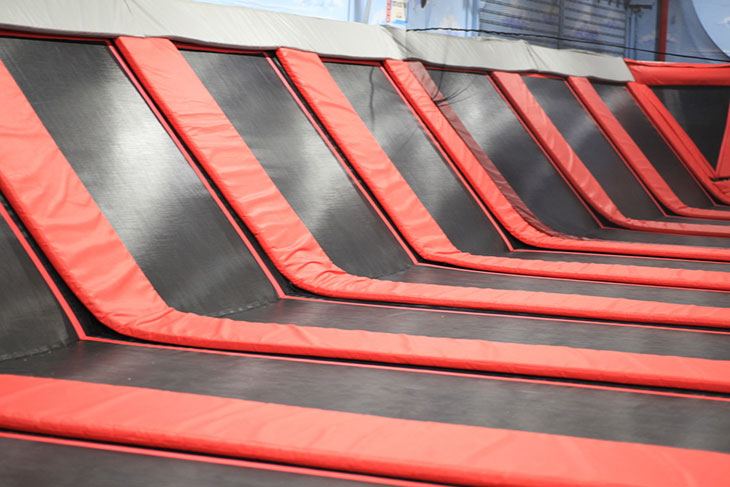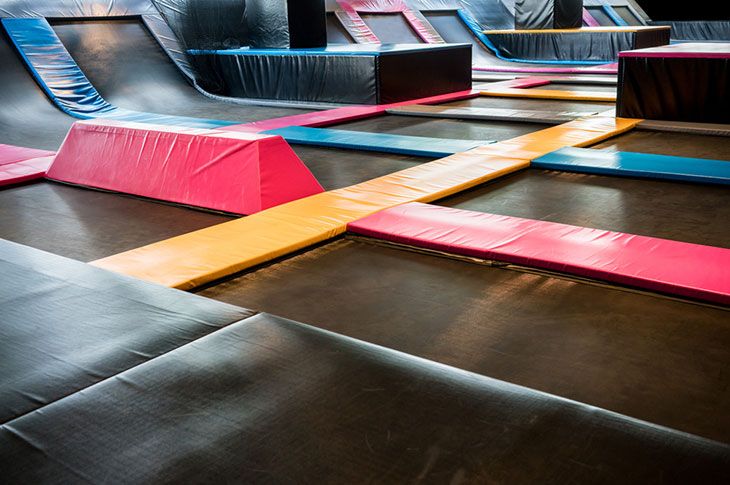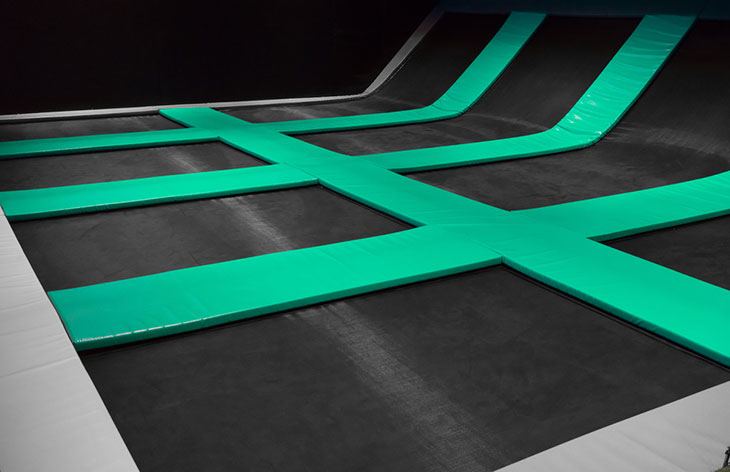If you've been snooping around the web, you know that there are too many trampoline products. There's a growing number of trampoline manufacturers every year, and the sheer number of trampolines is skyrocketing.
There are different designs, dedicated trampolines for gymnasts, and water bouncers for vacations - the bottom line is that you're probably overwhelmed and not sure what to get.
Also, a question that pops out time and time again is, What trampoline size should I get?
No worries, we'll try to answer every question you have about trampoline and even offer some insight into their build and how it correlates with the size in question. Stay tuned and learn all about trampolines!
More...
A Quick Table Overview
Since we'll be talking about trampolines a lot in this article, here's a quick overview for those who don't have the time and want to see the correlation between a child's age and the trampoline's size.
Age Range | Trampoline Size |
|---|---|
1-4-year olds | Mini Trampolines for Toddlers (4 feet) |
5-8-year olds | 6-10 feet Trampolines |
9-12-year olds | 10-12 feet Trampolines |
13-16-year olds | 12-16+ feet Trampolines |
The trampoline sizes in this table are based on the average height of children in the specific age group. If your kid is shorter or taller than the average for the specific group, you should consider the below or above.
Determining the Appropriate Trampoline Size: An Extensive Guide
1. The Size and Shape
Before we go into the topic of choosing the perfect size for you and your family, we have to understand the in-depth mechanics of trampolines and how they're actually measured. To do that, let's take a classic, round trampoline as an example.
In order to measure it, you'll need a long stick, ruler, or measuring tape to cover the entirety of the frame. You'll do two measurements, from one end of the frame to the other, across the centre. Many trampolines have the manufacturer's logo in the middle, so there's no need to call an expert mathematician to do it for you.
When you've done the first measurement, repeat the same process by moving 90 degrees in a different direction. When you're finished, you'll calculate the average because round trampolines often have dents or bends, so they're actually not made in a perfect circle.
Even though there's no need to know how to measure trampolines before you actually purchase them, the knowledge will come in handy when you have to buy some additional equipment or spare parts, such as the springs, jumping mats, or even enclosure nets.
When it comes to shape, trampolines are most often round or rectangular, but you can always come across hexagonal or oval models. If you've never owned a trampoline, we suggest that you either buy the most popular 8-foot trampoline with an enclosure net for children or a 12-foot round model that's great for the entire family.
Now, let's chat a bit more about the table at the beginning of the article.
2. Correlation Between Age and Size - Additional Factors
The table is just a general overview of the age group and the size that correspond to one another. However, there are more factors that you should consider. The first and most obvious thing to bear in mind is the number of children that will climb and use the trampoline.
Each trampoline has a certain weight limit that you shouldn't exceed if you want to keep all the parts intact and not worry about the possible damage to the springs and the jumping mat. Consequently, the safety of your children will be compromised if they exceed the weight limit.
The weight limit will almost always be included in the description of the product on Amazon, but if it's not there, make sure to contact the manufacturer's customer service and do some calculations.
The general rule of thumb is that 12-foot round trampolines can sustain around 250-350 lbs, based on the model and the overall quality of the build. Basically, it means that two average weight adult men can jump at the same time, three women, or four to five children.
Furthermore, you'll have to account for the quality of the trampoline. When we think of quality, the first two things that come to mind are the springs and the jumping mats.
All premium trampolines utilize galvanized steel in the manufacturing process of trampoline springs and some additional parts, such as poles and metallic supports. The reason galvanized steel is often used is due to its anti-corrosive properties that protect the trampoline from harsh weather and general wear.
When it comes to jumping mats, they're often made from polypropylene that is an excellent, resilient material.
So, how does this connect with the topic in question, the size of the trampolines?
Well, the manufacturer's instructions on the weight limit can oftentimes be pulled out from the general manuals and tables such as the one above.
However, if the quality is bad and the weight limit is not properly measured, the size of your trampoline will not be enough for your kids. It doesn't matter if a 12-foot trampoline can support 300 lbs if the springs are bad and will give out after a month.
You might want to consider buying a 14-foot trampoline or to look for a more stable and better trampoline.
3. The Relationship Between the Size and the Price
Naturally, you'd expect that larger trampolines cost more, and that's absolutely correct. The smaller trampolines are way more affordable than, the larger models, but there are some factors that you should keep stored in the back of your mind.
Firstly, bigger trampolines are not necessarily better than smaller models, even if they're more expensive. We're always inclined to believe that if something's expensive, it's got to be well made and durable. When it comes to trampolines, the quality does not improve with the increasing size since the price is closely connected solely with the size.
But are they worth the money?
Well, you should first think of how many people will be using the trampoline. You never know if you'll have more children in the future or if you'll need a larger trampoline for guests and family, so it might not be a bad idea to purchase a 14-foot or a 16-foot trampoline.
On the other hand, it's quite the investment considering that they can cost well over $500, especially if you're aiming at trampolines for gymnastics. So, where's the middle ground?
From personal experience, we can say that you can purchase a 14-foot trampoline and never worry about lacking space for the kids or the potential guests that want to extend their welcome. These models are generally quite sturdy and have weight limits above 350 lbs, which should be enough for the entire family to have fun.
Still, it is an investment, so think it through before you decide to buy it.
Our recommendation is that you should since trampolines have a long lifespan, and it's not something that you'll forget about in a year and leave it to rot in the backyard. After you've used it for many years, you can either lend it to a friend or leave it for the grandkids in the future since trampolines can even last for more than two decades.
4. The Ideal Height
There's no real answer or the appropriate height for a specific trampoline. The most boring answer is that the height is determined by the safety standards that correlate with the dimensions of the trampoline and its bounce ability, but that doesn't mean much in practice.
However, if we cross-reference the most popular models on Amazon at this moment and take out the average, we can make a list of the most common heights in correspondence with the diameter of the trampoline.
For example, 6-foot trampolines are made for children, so there's no real necessity for the trampoline to be high. The average for these models seems to be around 40 inches, which is around 101 cm. As the diameter grows, so does the height, so the average height for an 8-foot trampoline is around 80 inches, which is 203 cm.
10-foot models have a 100-inch height, 12-foot models usually have around 107 inches, and finally, the 14-foot trampolines will usually be around 110-inches high. Again, this is the average based on the products on the market, but it shouldn't be a surprise if the model you want to purchase has a different height.
5. Other Things To Consider
If you're purchasing an outdoor trampoline, you've probably done the measurements in the backyard and found the appropriate size of the model. However, it's vital that you add at least an additional diameter to your measurements for several reasons.
Firstly, that diameter is important for separating the trampoline from any other objects in the backyard that could potentially damage it during windy weather. Also, you don't want your trampoline very close to the house for the very same reason.
Secondly, you have to account for additional space for the ladder and somewhere to place your shoes. Generally, better trampolines have deposit bags below the ladder for your shoes and belongings, but that's not the case with every trampoline. Therefore, it's not a bad idea to count in that feet of extra space.
Also, we'd like to tell you about some of the best manufacturers of trampolines on the market. If you've already searched for a trampoline and ended up liking one, but there isn't an appropriate trampoline size, we get that. It's quite common that smaller manufacturers build a couple of models, and you can't find the one that fits your needs.
However, there are some manufacturers that you can always count on to deliver. Some of the best ones that we know of are Skywalker, JumpSport, Springfree, and Bounce Pro. There are a plethora of models that come directly from these manufacturers' facilities, and they're all well made and have a quality build.
Frequently Asked Questions
How do you know what size trampoline to get?
The most vital factors for choosing the perfect size of a trampoline are backyard space, the number of users, the weight limit, and the overall quality of the model.
If you're not sure about some of these, check out the guide above, where we made it a bit clearer.
What are the different sizes of trampolines?

Basically, you can find a size you need no matter the number of people you need it for.
If you're buying a trampoline for your toddler, 6-foot mini trampolines are the best option.
Generally, the size of the trampolines rises by two feet, so there are 8-foot, 10-foot, 12-foot models and so on. There are manufacturers that build odd-numbered diameter trampolines.
Also, if you're purchasing from a European manufacturer, their sizes will be expressed in centimetres, and they might have the exact size you're looking for.
Is a 12 ft trampoline big enough?
It is a common understanding that 8-foot trampolines are perfect for families that have two children and that 12-foot trampolines are the best for the entire family.
They can usually sustain up to 350 lbs, which is more than enough for you to jump with your children without worrying about safety.
Should I get a 12 or 14-foot trampoline?
We've covered this above in the article, but to summarize, 12-foot round trampolines are always a safe choice for an average-size family.
On the other hand, the quality of a trampoline could be questioned if it comes from an unverified manufacturer, and that is when you would want to consider buying a 14-foot model.
Also, 14-foot trampolines generally have a larger weight capacity and more space to maneuver, so if your kids want to be gymnasts, this is the size for them.
Final Thoughts - Conclusion
We hope that this trampoline sizes guide was everything you needed and that now you're prepared to go online and find the perfect fit for you.
Our recommendation is to go for the Skywalker models since they have a lot of positive reviews, and they're undoubtedly one of the best manufacturers, if not the best, out there.
Let us know what you think, and make sure to comment about the experiences you'll have when you buy your brand new trampoline.
No products found.
My name is Larry Dunn from Dallas Texas and I have a deep passion and love for the trampoline.
With many years of experience in the field of healthcare service, I have decided to start his own website which is about a trampoline.
With this website, I will share his experiences and expertise advices on different factors to consider when deciding whether or not a trampoline is safe for you and your family.


